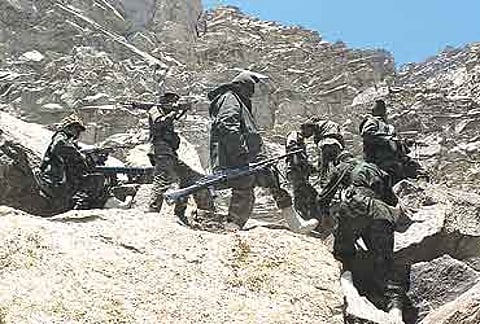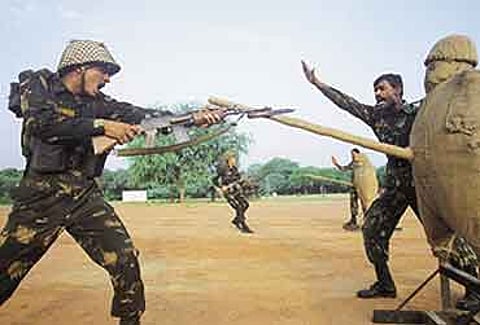War Against Error
The Indian army was shocked and awed by the Kargil war. Five years on, its internal assessment report lists the blunders it made, and steps to avert them in the future.
- Senior commanders reached late. There were lapses in command and control.
- There was total intelligence failure
- It was presumed that an overt nuclear posture would guarantee peace
- The army was in low intensity conflict mode and unprepared for a conventional war
- There was a sense of complacency. It was assumed there would be no incursion across difficult and harsh terrain.
- Senior officers were physically unfit. And there was lack of initiative at the JCO-NCO level.
- Northern Command was stretched and troop levels were not adequate

The ongoing peace process, kicked off by the Lahore bus ride of then Prime Minister Atal Behari Vajpayee, and the fact that both India and Pakistan had gone "overtly nuclear" led the army top brass to believe that war was a distant possibility.
The assessment also recognises another factor that caused much heartburn within the army's higher echelons—the fact that there were no inputs from the Research & Analysis Wing (RAW). It was the agency's task to gather foreign intelligence. While RAW did manage an "intelligence scoop by intercepting a call between Gen Pervez Musharraf and his chief of staff", there were no initial inputs on the extent of incursions into Kargil. The fact that there were "no ground sensors" on the 130 km stretch also adversely affected the army's ability to preempt the incursions. It has also been put on record that Military Intelligence was unable to "analyse certain inputs". For instance, there were reports of "large-scale animal transport movements on the Pakistani side of the LoC".However, military intelligence summarised that these were undertaken to replenish ammunition for the Pakistani artillery regiments. Later, it was learnt that this was part of the 'Kargil plan'.
Lessons: A range of new technology has been introduced, including regular flights by unmanned aerial vehicles. The army pressed for a fence on the Line of Control to effectively check infiltration. With a drop in infiltration, the senior commanders can keep their troops readied for conventional operations. It was also decided that winter posts would not be vacated. A Defence Intelligence Agency (DIA) was created along with the National Security Council secretariat and Military Intelligence was refurbished and "strengthened" by then army chief General S. Padmanabhan.

Seniors Unfit, Juniors Lax
The assessment points out that with an older profile of "commanders at the battalion and brigade level", the army was literally gasping for breath. Two commanding officers of infantry battalions were moved out as they were physically unfit to deal with the demands made by the rugged terrain, high altitude and the rigours of war. The report also points out that equivalent Pakistani commanders were "younger by three to four years."
A sizeable proportion of the 474 killed during the war were young commissioned officers (lieutenants and captains) who had just passed out of the Indian Military Academy and had joined their respective units. The high casualty rate among them has been largely attributed in the assessment to the "severe lack of initiative in the junior leadership", specifically among Junior Commissioned Officers (JCOs) and Non-Commissioned Officers (NCO) who are platoon commanders. They were also found to be averse to taking risks. Finally, if the war was won, the report says, it was due to the "courage and leadership of the young (commissioned) officers" who "carried the bulk of the burden".
Lessons: On Army Day last year, the partial implementation of the Ajai Vikram Singh Committee report was announced by Gen Vij. The government finally gave the clearance in December 2004 for its full implementation, allowing a host of younger officers to assume command of battalions. In the last two years, army headquarters has been working furiously to establish an academy for NCOs to motivate them and to hone their battle-craft.

Northern Command Stretched
The report points out that "the Udhampur-based Northern Command was stretched" and unable to "cope with the emerging threat of war." While it had to oversee live operations in the mountains in and around Kargil, it also had to maintain vigil on the LoC and the international border. Consequently, it was also engaged in counter-insurgency operations. There was a need to "rationalise the command and the control structure". The Srinagar-based 15 Corps was found to be inadequate to control operations east of the Zojila Pass which led to the debacle. "In the initial stages, the corps had only one division to deal with the exigency."
The report also recognises the fact that due to "operational urgency" troops had to be rushed to forward areas without acclimatisation. Acclimatisation is mandatory for all troops before being inducted into high-altitude areas.
Lessons: Cleared by the government in January this year, the new South-West Command will help rationalise this anomaly and enable quicker deployment and immediate commencement of operations. The army also created the Leh-based 14 Corps with three divisions to beef up its presence in the Kargil sector.